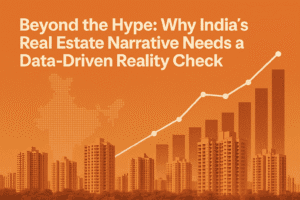Beyond the Hype: Why India’s Real Estate Narrative Needs a Data-Driven Reality Check
India’s real estate market, especially in hotspots like Gurugram, is dominated by speculation where properties are bought primarily as flip-assets, not homes, creating a fragile “house of cards.” This environment thrives because “insiders” – brokers, influencers, consultants, and developers – relentlessly push unchecked optimism and FOMO to sustain transactions and prices. Crucially, their bullish narrative faces little challenge due to a severe lack of transparent, regular market data.
Without accessible figures on actual sales, true inventory levels, realistic rentals, or timely price trends, objective analysis is stifled, leaving genuine buyers vulnerable. This data vacuum perpetuates hype, distorts the market, and makes affordable housing a mirage.
The consequences are real: households face financial strain from inflated prices, locked homes worsen scarcity, and resources are misallocated. India urgently needs robust, publicly-available data across seven key areas – from registrations to loans to price indices – to replace speculation with honesty and align prices with actual value and need. Only then can the market serve people seeking homes, not just profits for speculators and insiders.

Beyond the Hype: Why India’s Real Estate Narrative Needs a Data-Driven Reality Check
The warning shot from Gurugram influencer Vishal Bhargava – labeling the city’s real estate a “house of cards” – struck a nerve. His core argument resonated deeply: much of India’s premium property, particularly in hotspots like Gurugram, has morphed from shelter into a speculative financial asset. Homes aren’t primarily bought to live in; they’re bought to flip. Pay-as-you-go schemes fuel a market where investors trade on margin, driven by FOMO, hoping to sell before the final installment is due. This isn’t healthy growth; it’s a game of musical chairs played primarily by speculators.
The Deafening Roar of Perpetual Optimism
Bhargava’s cautionary note was swiftly drowned out. The real estate “insiders” – brokers, consultants, influencers, and developers (often off-record) – responded with a familiar chorus: bullishness is eternal. Gurugram prices, they claimed, are poised to rival Mumbai’s. This relentless optimism isn’t accidental; it’s systemic. Borrowing from economist Charles Kindleberger’s concept, the market is dominated by “insiders” whose income depends on transactions. Their mantra, as one Mumbai broker candidly admitted years ago, is “Tezi ki hawa bani rehni chahiye” – the atmosphere of bullishness must be perpetually maintained.
These insiders dominate the narrative:
- Consultants funded by developers release weekly bullish reports.
- Broker-Influencers flood social media with unchecked optimism and FOMO-inducing content.
- Developer Lobbies relentlessly push price-rise narratives.
- Marketing Incentives steer brokers towards selling new inventory over clearing locked, investor-held older stock.
The problem isn’t that insiders promote their interests; it’s that their voice is virtually the only one heard. Unlike the stock market, where bearish analysts and contrarian fund managers provide balance, Indian real estate commentary suffers from a critical deficiency: a near-total absence of credible, accessible data to counter the hype.
The Crippling Data Void: Fueling the Hype Machine
Why is dissent so rare? The fundamental obstacle is a staggering lack of transparent, regular, and comprehensive real estate data. Without this, objective analysis challenging the perpetual bullish narrative is nearly impossible. The media, reliant on insiders for quotes and information, becomes an echo chamber of optimism.
India urgently needs these seven data pillars:
- Monthly Home Registrations: Reliable, city-level figures on actual sales closing (beyond just launches).
- New Project Launches: Tracking promised supply additions across major cities (possible via RERA infrastructure).
- National Rental Index: Gauging real rental yield trends and affordability pressures.
- Transparent Inventory Tracking: Regular data on total unsold units and investor-locked homes (Income Tax data could be a start).
- Granular Housing Loan Data: Monthly RBI reports on loans by city, price point, and lender type (NBFCs included).
- Market vs. Circle Rate Gap: Publishing the divergence between official rates and actual transaction prices.
- Robust Monthly Price Index: Moving beyond the RBI’s lagging quarterly index to a timely, reliable national benchmark.
The Real Cost of Unchecked Optimism
This isn’t just an academic exercise. The dominance of hype over data-driven honesty has tangible, damaging consequences:
- The Affordable Home Mirage: Skyrocketing prices, fueled by speculation, push genuine homeownership further out of reach for millions. Builders ignore affordable segments, chasing premium speculator profits.
- Household Financial Fragility: Families stretching to buy overpriced homes face crushing EMIs, leaving them vulnerable to financial shocks with minimal savings.
- Locked Homes & Artificial Scarcity: Investors holding units empty for future gains exacerbate housing shortages in crowded cities.
- Systemic Economic Distortion: Resources are misallocated towards speculative building, impacting broader economic health and corporate costs.
From Hype to Honesty: Building a Sustainable Market
India’s real estate story is indeed “only half told – but fully sold” on insiders’ terms. The path to a healthier, more equitable market lies in dismantling the information asymmetry. Establishing the seven data pillars isn’t merely a bureaucratic task; it’s a necessity for informed decision-making by buyers, policymakers, and even responsible developers.
Think tanks or government bodies must spearhead this data revolution. Only with transparency can we move beyond the dangerous game of musical chairs, where unchecked speculation benefits the few while the many – genuine homebuyers and the economy itself – pay the price. True value in real estate emerges when price, fundamental need, and transparent data converge. Until then, the hype will continue to mask a far more complex, and often precarious, reality.
You must be logged in to post a comment.